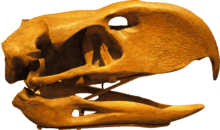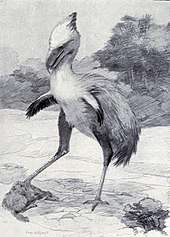Phorusrhacos
Phorusrhacos (/ˌfɔːrəsˈrɑːkɒs/ FOR-əs-RAH-koss) is an extinct genus of giant flightless terror birds that inhabited Argentina during the Miocene epoch.[1] Phorusrhacos was one of the dominant land predators in South America at the time it existed.[2] It is thought to have lived in woodlands and grasslands.
| Phorusrhacos | |
|---|---|
 | |
| Reconstructed skull, Royal Ontario Museum | |
| Scientific classification | |
| Kingdom: | Animalia |
| Phylum: | Chordata |
| Class: | Aves |
| Order: | Cariamiformes |
| Family: | †Phorusrhacidae |
| Subfamily: | †Phorusrhacinae |
| Genus: | †Phorusrhacos Ameghino 1887 |
| Type species | |
| †Phorusrhacos longissimus Ameghino 1887 | |
| Synonyms | |
|
Genus synonymy
Species synonymy
| |
Description
Phorusrhacos had a skull nearly 65 centimetres (26 in) long, stood nearly 2.4 metres (7.9 ft) tall, and probably weighed nearly 130 kilograms (290 lb), as much as a male ostrich.[3][4] It had very strong legs, capable of running at high speed, stubby, flightless wings, a long neck, and a proportionately large head. This ended in a huge, hooked beak that could tear through flesh easily, or stab into prey. The lower jaw was smaller than the upper jaw. There were three toes on each of the feet, all of which were armed with sharp claws.[2]
Discovery and naming

Remains are known from several localities in the Santa Cruz Formation and Monte León Formation in the Santa Cruz Province, of Argentina.[1] Among the bones found in the strata of the Santa Cruz Formations (now considered as mainly of mid-Miocene date) was the piece of a mandible which Florentino Ameghino discovered in early 1887 and the same year at first described as that of an edentate mammal which he named Phorusrhacos longissimus.
The generic name is derived from Greek -φόρος, (-phoros), an element meaning "bearer" in word combinations, and ῥάκος, (rhakos), "rag" or "wrinkle", probably in reference to the wrinkled jaw surface.[5] When the original derivation was no longer understood, other translations were given, such as the literal translation of "Rag-Thief",[6] and "branch-holder" from the mistaken assumption the name had been intended to be derived from a Greek rhakis, "branch".[7] The specific name means "very long" in Latin, again in reference to the lower jaws. The holotype is the mandible, specimen MLP-118 (Museo de La Plata). In 1889 Ameghino emended the name to a more grammatically correct Phororhacos but the earlier name has priority. In 1891, it was by him recognized to be a bird.[8]
Classification
Phorusrhacos was part of the group called the Phorusrhacidae, which is an extinct group of flightless, cursorial carnivorous birds that occupied one of the dominant, large land-predator niches in South America from the lower Eocene to the Pleistocene. They dispersed into North America during the Great American Biotic Interchange(∼3 Ma). Some remains from Africa and Europe and the Paleocene of Brazil have been referred to this clade or identified as phylogenetically related to the extant South American seriemas, but these assignments remain controversial.[9]
References
- "Phorusrhacos". Fossilworks. Retrieved 30 March 2020.
- Richardson, Hazel (2003). Dinosaurs and Prehistoric Life. London: Dorling Kindersley Limited. p. 183. ISBN 0-7513-3734-X.
- Croft, Darin A. (2016). Horned Armadillos and Rafting Monkeys: The Fascinating Fossil Mammals of South America. Indiana University Press. p. 120. ISBN 978-0253020840. Retrieved 30 March 2020.
- Alvarenga, Herculano M. F. & Höfling, Elizabeth (2003). "Systematic revision of the Phorusrhacidae (Aves: Ralliformes)". Papéis Avulsos de Zoologia. 43 (4): 55–91.CS1 maint: multiple names: authors list (link)
- Creisler, Ben. "Phorusrhacos "wrinkle bearer (jaw)": Etymology and Meaning". Dinosaur Mailing List.
- "Phororhacos". Century Dictionary.
- Lydekker, R. (1893). "On the extinct giant birds of Argentina". Ibis series 6 (5): 40–47. Cite journal requires
|journal=(help) - Ameghino, F. (1891). "Mamíferos y aves fósiles argentinas. Especies nuevas, adiciones y correcciones". Revista Argentina de Historia Natural. 1: 240–259.
- Federico J. Degrange, Drew Eddy, Pablo Puerta, & Julia Clarke (2019). "New skull remains of Phorusrhacos longissimus (Aves, Cariamiformes) from the Miocene of Argentina: implications for the morphology of Phorusrhacidae". Journal of Paleontology. 93 (6): 1221–1233. Retrieved 30 March 2020.CS1 maint: multiple names: authors list (link)